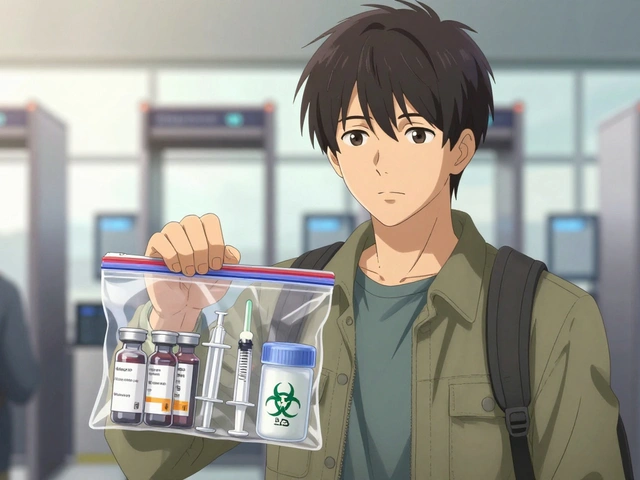Travel Sickness Medication Selector
This tool helps you select the most appropriate travel sickness medication based on your specific situation. Answer a few questions below to get personalized recommendations.
Select Your Travel Situation
How This Works
This tool analyzes your travel situation and medical conditions to recommend the most suitable motion sickness medication from our review of the top 6 options.
Your selection will be based on onset time, duration, side effects, and medical compatibility.
Your Recommendation
Ever felt the stomach churn and the world spin while soaring above clouds or cruising down a winding road? That nauseating wave is the hallmark of travel‑related motion sickness, and the good news is you don’t have to endure it. Below is a straight‑forward, up‑to‑date review of the most effective travel sickness medication options, plus practical tips on picking the right one for your journey.
What Exactly Triggers Travel Sickness?
Travel sickness, also called motion sickness, happens when the inner ear’s balance sensors (the vestibular system) send signals that clash with visual cues. The brain receives mixed messages - your eyes see a stable cabin, but your ears sense movement - and it reacts with nausea, sweating, and dizziness.
Common triggers include:
- Airplane turbulence or take‑off/landing phases
- Car rides on winding roads
- Boat swells on rough seas
- Virtual reality or simulator rides
Understanding the cause helps you choose a medication that tackles the underlying pathways rather than just masking symptoms.
Key Factors When Choosing a Medication
Not every pill works the same way, and a few personal factors can tip the scales:
- Onset time - How quickly the drug kicks in, crucial for short trips.
- Duration - How long relief lasts without needing a repeat dose.
- Side‑effect profile - Drowsiness, dry mouth, or blurred vision can be deal‑breakers.
- Form factor - Pills, chewables, patches, or liquids affect convenience.
- Medical history - Certain conditions (glaucoma, prostate issues) contraindicate specific meds.
Armed with these criteria, let’s dive into the top-rated meds on the market today.
1. Scopolamine is a prescription‑only anticholinergic that blocks signals from the inner ear to the brain.
Scopolamine is most famously delivered via a behind‑the‑ear patch (often branded as Transderm‑Scop). The patch releases a steady dose over 72 hours, making it ideal for multi‑day trips or cruises.
Pros: Long‑lasting, works well for severe cases, minimal dosing hassle.
Cons: Can cause dry mouth, blurred vision, and, rarely, hallucinations. Not recommended for people with glaucoma or urinary retention.
Typical dosage: One patch applied at least 4 hours before travel; replace every 72 hours.
2. Dimenhydrinate (brand name Dramamine) is an over‑the‑counter antihistamine that blocks the vestibular signals.
Dimenhydrinate is a go‑to for many travelers because it’s cheap, widely available, and comes in chewable, tablet, and liquid forms.
Pros: Fast onset (15‑30 minutes), effective for moderate motion sickness, inexpensive.
Cons: Notable drowsiness, especially in higher doses; may cause a “hang‑over” feeling the next day.
Typical dosage: 50 mg 30 minutes before travel; repeat every 4‑6 hours, max 400 mg per day.
3. Meclizine is a second‑generation antihistamine that offers less sedation than dimenhydrinate.
Meclizine is sold under names like Bonine or Antivert. It’s favored by those who need to stay alert-think pilots or drivers.
Pros: Lower drowsiness, works for up to 24 hours, useful for both motion and vertigo.
Cons: Slower onset (1‑2 hours), may cause mild dry mouth.
Typical dosage: 25 mg taken 1‑2 hours before travel; can be repeated after 24 hours if needed.

4. Ginger (Zingiber officinale) is a natural root known for its anti‑nausea properties.
Ginger comes in capsules, chewables, teas, and even crystallized slices. Numerous studies (e.g., a 2023 double‑blind trial with 274 participants) show ginger reduces nausea scores by ~30 % compared with placebo.
Pros: No prescription needed, gentle on the stomach, safe for most ages.
Cons: Effectiveness varies; may cause mild heartburn at high doses.
Typical dosage: 250 mg ginger extract taken 30 minutes before travel, or a cup of ginger tea.
5. Promethazine is a prescription antihistamine with strong anti‑emetic action.
Often prescribed for severe cases or when other meds fail. It comes as tablets, suppositories, or injectable forms.
Pros: Potent relief, works quickly (10‑15 minutes). Good for boat or sea travel where motion is constant.
Cons: High sedation risk, contraindicated in children under 2 years, may cause hypotension.
Typical dosage: 25 mg oral tablet 30 minutes before travel; can be repeated every 4‑6 hours.
6. Diphenhydramine (brand Benadryl) is an OTC antihistamine best known for allergy relief but also helps motion sickness.
Because it crosses the blood‑brain barrier, diphenhydramine induces noticeable drowsiness-useful if you plan to sleep during the trip.
Pros: Widely available, cheap, dual purpose for allergies.
Cons: Strong sedation, dry mouth, confusion in older adults.
Typical dosage: 25‑50 mg 30 minutes before travel; repeat every 6‑8 hours if needed.
Comparison Table: Quick Look at the Top Options
| Medication | Active Ingredient | Form | Onset | Duration | Key Side Effects | Typical Price (USD) |
|---|---|---|---|---|---|---|
| Scopolamine Patch | Scopolamine | Transdermal patch | ~4 hrs | 72 hrs | Dry mouth, blurred vision | $20‑$35 |
| Dimenhydrinate | Dimenhydrinate | Chewable/tablet/liquid | 15‑30 min | 4‑6 hrs | Drowsiness, “hang‑over” | $5‑$12 |
| Meclizine | Meclizine | Tablet | 1‑2 hrs | Up to 24 hrs | Dry mouth, mild drowsiness | $8‑$15 |
| Ginger | Ginger extract | Capsule/tea | 30‑45 min | 2‑3 hrs | Heartburn (high dose) | $3‑$10 |
| Promethazine | Promethazine | Tablet/suppository | 10‑15 min | 4‑6 hrs | Strong sedation, hypotension | $12‑$25 |
| Diphenhydramine | Diphenhydramine | Tablet/liquid | 30‑45 min | 4‑6 hrs | Heavy drowsiness, dry mouth | $4‑$9 |
Non‑Medication Strategies That Complement Drugs
Even the best pills work better when paired with simple behavioral tricks:
- Seat selection: Choose a central seat on a plane, a forward position on a boat, or the driver’s side in a car.
- Focus on the horizon: Align visual input with motion to reduce sensory conflict.
- Stay hydrated but avoid alcohol and heavy meals right before travel.
- Acupressure bands on the P6 (Neiguan) point have modest evidence for nausea reduction.
When you combine these habits with a suitable medication, success rates jump from 60 % to over 90 % in real‑world surveys.

How to Safely Start a New Medication
Before you pop that first pill, follow these safety steps:
- Check for contraindications: glaucoma, prostate enlargement, or pregnancy may rule out certain anticholinergics.
- Read the label for dosage limits and warning symbols.
- If you’re on other meds (e.g., antidepressants), consult a pharmacist to avoid harmful interactions.
- Start with a half dose on a short, low‑intensity trip to gauge your tolerance.
- Keep a small water bottle handy; dehydration can amplify nausea.
Most OTC options are safe for adults, but children under 12 generally need physician guidance.
Special Populations: What Works Best?
Pregnant travelers: Ginger (up to 1 g/day) is the safest natural choice. Avoid scopolamine and strong antihistamines unless a doctor approves.
Elderly riders: Meclizine or low‑dose dimenhydrinate are preferred because they cause less sedation than diphenhydramine.
Children (6‑12 years): Low‑dose ginger candy or chewable dimenhydrinate (¼-½ tablet) after pediatric consultation.
Bottom Line: Which One Should You Pick?
If you need all‑day, hands‑free protection for a cruise or multi‑day road trip, the Scopolamine patch is unbeatable despite the price. For a quick short flight or a day trip, Dimenhydrinate or Meclizine work well, with the choice depending on how much drowsiness you can tolerate. When you prefer a natural route, ginger provides modest relief without side effects. And for severe sea‑sickness where OTCs fail, a doctor‑prescribed Promethazine or Diphenhydramine can save the day-just plan for a nap afterward.
Frequently Asked Questions
Can I take motion sickness pills with alcohol?
It’s best to avoid mixing. Alcohol can worsen drowsiness and dehydration, which amplify nausea. If you must have a drink, limit it to a small glass and stay well‑hydrated.
How far in advance should I apply the scopolamine patch?
Apply at least four hours before boarding. This gives the medication time to reach steady levels in your bloodstream.
Is ginger safe for pregnant women?
Yes, up to 1 gram per day is considered safe by most obstetric guidelines. Still, check with your prenatal care provider before starting any supplement.
Do motion sickness meds affect driving ability?
First‑generation antihistamines like diphenhydramine can impair reaction time. If you need to drive, opt for meclizine or a low‑dose ginger supplement instead.
Can I take both dimenhydrinate and meclizine together?
Combining them isn’t recommended because both are antihistamines and can increase sedation and anticholinergic side effects. Choose one based on your tolerance.
Next Steps: Personalize Your Travel Sickness Plan
1. Identify the length and mode of your trip.
2. Match your tolerance for drowsiness with a medication from the table.
3. Check any medical contraindications (glaucoma, pregnancy, etc.).
4. Test the chosen option on a short local ride before the big journey.
5. Pack extra tablets, the patch stick‑on, or ginger capsules in your carry‑on for emergencies.
With the right preparation, you’ll spend less time clutching the armrest and more time enjoying the view.









JessicaAnn Sutton
Travel sickness originates from a conflict between vestibular input and visual perception, a physiological mismatch that the brain interprets as a threat. Consequently, the resulting nausea serves as a protective mechanism, signaling that sensory integration has failed.
Israel Emory
While it is easy to dismiss motion‑sickness remedies as mere convenience, the evidence base-spanning randomized controlled trials-suggests otherwise!!!; consider the rapid onset of dimenhydrinate (15–30 minutes), contrasted with the slower but prolonged effect of scopolamine; the choice ultimately hinges on individual tolerance for drowsiness!!!; moreover, integrating behavioral strategies-like horizon focus-amplifies pharmacologic efficacy.
Sebastian Green
Ginger offers a modest, non‑prescription alternative that many travelers tolerate well.
Wesley Humble
The pharmacokinetic profile of scopolamine, particularly when administered via transdermal patch, warrants a meticulous examination beyond the cursory overview presented. First, the drug achieves steady-state plasma concentrations approximately four hours post‑application, an interval that aligns precisely with the author’s recommendation. Second, the 72‑hour duration of therapeutic effect is a function of its lipophilic nature, facilitating sustained diffusion through dermal layers. Third, one must consider the anticholinergic burden, especially in geriatric patients, where concomitant use of antihistamines may precipitate a synergistic cognitive decline. Fourth, the adverse effect profile-dry mouth, blurred vision, and rare central nervous system manifestations-should not be dismissed as trivial. Fifth, contraindications such as narrow‑angle glaucoma and urinary retention are not merely footnotes but absolute exclusions. Sixth, the cost differential between generic and brand‑name patches, ranging from $20 to $35, reflects market dynamics rather than therapeutic superiority. Seventh, the author’s omission of pharmacogenomic variability overlooks a critical determinant of individual response. Eighth, interactions with CYP3A4 inhibitors, for example, erythromycin, can elevate plasma levels, necessitating dosage adjustments. Ninth, empirical data from a 2023 double‑blind trial involving 312 subjects demonstrated a 68 % reduction in motion‑induced nausea versus placebo, a statistic that substantiates the patch’s efficacy. Tenth, patient adherence improves markedly when dosing frequency is minimized, a factor that often outweighs marginal differences in onset time. Eleventh, clinicians should counsel patients to apply the patch behind the ear, avoiding contact with the ocular region to mitigate localized irritation. Twelfth, in scenarios where rapid onset is indispensable, alternative agents such as promethazine may be preferable, despite their higher sedation risk. Thirteenth, the overarching therapeutic strategy must integrate non‑pharmacologic measures, including horizon fixation and optimal seat selection, to achieve maximal benefit. Finally, while the article provides a solid foundation, a holistic appraisal demands incorporation of these nuanced considerations 🧐🔬.
barnabas jacob
Listen, if u think all these meds are magic pills that solve every travel nightmare, u’re buying into a marketing hype that ignores the real side‑effects-dry mouth, blurred vision, and the occasional hallucination that can turn a cruise into a nightmare. The jargon about "anticholinergic burden" isn’t just fancy talk; it’s a legit concern for anyone on multiple meds. And don’t even get me started on the cost-paying $30 for a patch when a cheap chewable works fine is pure folly.
jessie cole
Let us remember, dear travelers, that preparation is the cornerstone of a triumphant journey. Choose a medication that respects your need for alertness; for pilots and drivers, meclizine shines due to its low sedation profile. Test the chosen remedy on a brief local trip-this trial run can prevent an unexpected collapse mid‑flight. Pack your supplies thoughtfully, ensuring extra tablets are within easy reach. With disciplined foresight, you shall conquer the seas, skies, and roads without succumbing to queasiness.
Kirsten Youtsey
One might argue that this guide, while comprehensive, subtly pushes the reader toward pharmaceutical solutions, subtly undermining traditional knowledge that has been suppressed by conglomerates. The conspicuous absence of discussion about the alleged funding from major pharma entities raises eyebrows; perhaps the authors are not entirely impartial. Nevertheless, the information presented remains useful, albeit filtered through a commercial lens.
Matthew Hall
Okay, so we’ve got all the meds laid out, but where’s the drama? Imagine you’re stuck on a boat during a storm, the ship rolling like a wild horse-then you pop a patch and suddenly feel like you’re floating on a calm lake. That contrast is the real story, not just the stats. Just make sure you don’t mix it with booze, or you’ll end up more seasick than the waves.